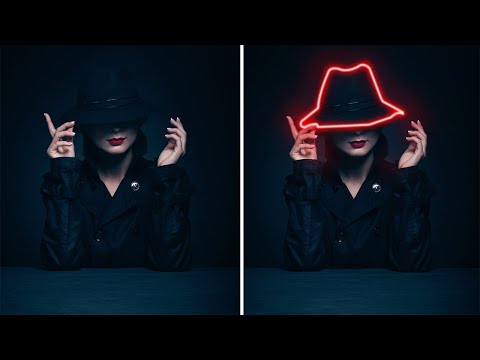Step One: Create Your Type
Open a new document in Photoshop and set the background to black – you’ll be using some blend modes and the dark background will help you see the glow effect while you work. (White or transparent backgrounds makes it hard to see what the effects are doing.)
Now we put on our washed-teal O.P. shorts.
Step Two: Copy Your Type Layer
Copy the type layer so there are two RADICAL type layers. This allows me to treat the shape of the letters with the glow while being able to edit the fill of the letters separately.
I’ll make both layers 100% Cyan for the vaporwave look by clicking on the text color box in the Character palette. You can choose whatever neon-compatible color fits your design.
Group the layers by selecting both type layers and clicking on the folder icon at the bottom of the Layers palette. This lets you move the layers around in tandem.
Select the top type layer and reduce Fill to 0% – this makes the letters themselves invisible but will allow the glow effect to remain visible on the edges. Now, turn off the bottom layer’s visibility by clicking the eyeball icon at the left side of the layer name, so we can concentrate on the top layer
Step Three: Make the Glow in Layer Style
Open the Layer Style panel by double-clicking on the top type layer, or by clicking Layer in the menu bar, then Layer Style. In the Blending Options section, check Outer Glow from the left-hand menu and its controls will appear in the middle of the window.
In the Structure section, set the Blend Mode to Screen, with 70% opacity. Click the color thumbnail, also in the Structure section, to change it to a hot magenta, which pairs well with the cyan of the title for this look.
The following controls in the Elements section are set depending on the size of your document. For this 2880x1800px image, the Technique is set to Precise – the Softer technique made the glow at the corners of the thin letters too rounded.
Continuing in the Elements section, Spread controls the fade saturation from the edge of the object that the glow is emanating from. We don’t need to manipulate Spread because the corners are well defined by using Precise for the Technique. The Size is at 50px, but for a smaller image it would be less, by scale.
We’ll leave the Quality section as-is. The Contour is left at a straight diagonal chisel, which also contributes to the uniform glow we’re after.
For bolder or thicker letters, or different patterned backgrounds, you may want to choose Smooth for the Technique. The Elements area is where you’ll adjust for the size of your image, as every other control is based on percentage and therefore scales with your image.
Hit OK. Now you should see the glowing neon border around your type.
Step Four: Finishing Touches
Return to the Layers panels and turn on visibility for the bottom type layer so you can see the cyan base again.
I went ahead and made an ’80s inspired, vaporwave style smart object in Illustrator to show how these techniques can be combined for a simple, minimalist design.
Since I’m using a design element with stripes in alternating gradients and black, I set the type layer Blend Mode to Screen by selecting it from the drop-down menu in the Layers palette. This gives it that VHS-quality look.
The Screen blend mode interacts with the background by increasing lightness where the colors in that layer are on top of another layer with a color lighter than black – in this case, the pink-blue gradient. It essentially multiplies the white level in its respective layer.
I encourage you to experiment with different backgrounds and elements stacked on top of each other, where the Blend Modes will interact differently.

